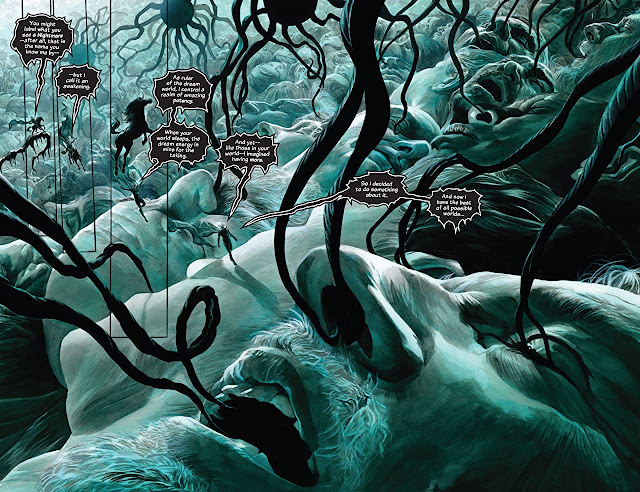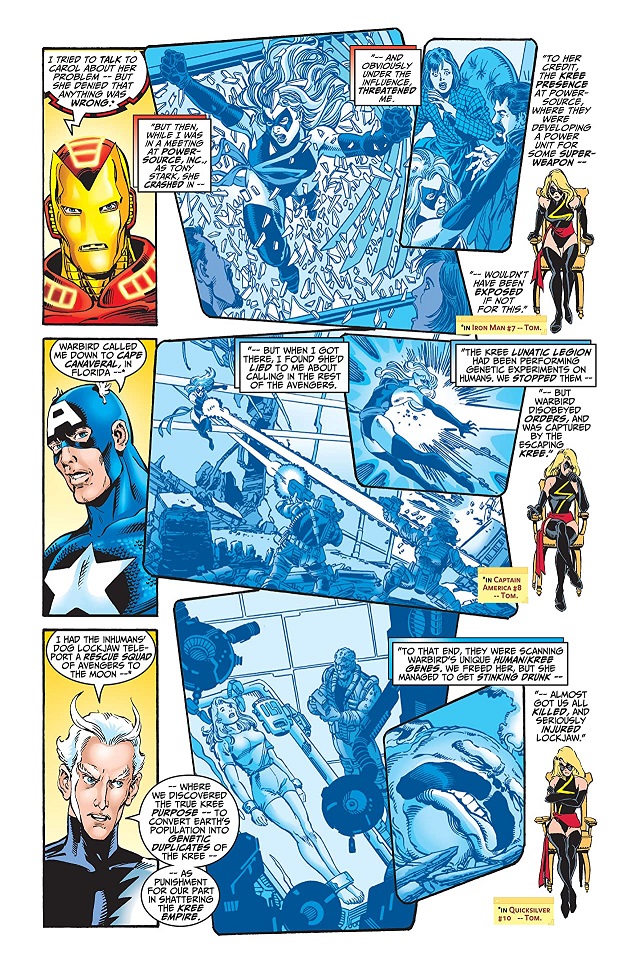In 1939, a small publisher by the name of Timely Comics released an anthology titled Marvel Comics. 30 years later, after the arrival of Stan Lee, that company became Marvel Comics forever changing the history of the medium. 80 years have passed since the publication of Marvel Comics #1, and as part of the Marvels anniversary, Kurt Busiek and Alex Ross have decided to pay homage to the title that started it all, so much in fact that the magnificent cover by Ross takes as inspiration that of the 1939 comic.
As it was common at the time, comics usually followed the anthological format, featuring several short stories by different creative teams, just like Action Comics or Detective Comics. And certainly, Marvel #1 (May 2020) is true to the essence of yesteryear. In “Overture”, Alex Ross and Steve Darnall write about Nightmare, one of Doctor Strange’s most powerful villains. Alex Ross is also in charge of the interior art, and his pages are absolutely beautiful. In the first page, Nightmare is riding a horse through a landscape that doesn’t seem to belong to this world, and that is only the prelude of an extraordinary double page spread, in which we see dozens of heads, eyes closed, all of them, and on top, Nightmare, going from one panel to the next, connected to the dreaming minds of everyone. And the sequence that takes place in New York is beyond great!
In “Spider-Man: Make My Day”, Sajan Saini and Frank Espinosa tell a rather amusing story about Peter Parker and Mary Jane, dealing with the increasing costs of the ingredients needed for the web fluid, and the subsequent attack of the Rhino. The coloring is great but the art itself is a bit obscure sometimes, or is excessively trying to be impressionistic when, as well know, in comics there can be nothing better than figurative art.
“The Boy… and the Brute” is written by Kurt Busiek and illustrated by legendary artist Steve Rude, who adds a certain ‘retro’ style to his designs in this story that takes place in the Avengers’ past. The boy, of course, is Rick Jones, and the brute is the Hulk, two characters that share a unique connection, since one of them was responsible for the other’s transformation into an unstoppable green monster. All in all, a fantastic beginning for this new anthology!
________________________________________________________________________________________________________
________________________________________________________________________________________________________
En 1939, una pequeña editorial llamada Timely Comics publicó una antología titulada Marvel Comics. 30 años después, tras la llegada de Stan Lee, esa empresa se convirtió en Marvel Comics cambiando para siempre la historia del medio. Han pasado 80 años desde la publicación de Marvel Comics # 1, y como parte del aniversario de Marvels, Kurt Busiek y Alex Ross han decidido rendir homenaje al título que lo inició todo, tanto así que la magnífica portada de Ross está inspirada en la del cómic de 1939.
Como era común en ese momento, los cómics solían seguir el formato antológico, presentando varios relatos de diferentes equipos creativos, al igual que Action Comics o Detective Comics. Y ciertamente, Marvel # 1 (mayo de 2020) es fiel a la esencia de antaño. En "Obertura", Alex Ross y Steve Darnall le dan vida a Nightmare, uno de los villanos más poderosos de Doctor Strange. Alex Ross también está a cargo del arte interior, y sus páginas son absolutamente hermosas. En la primera página, Nightmare monta a caballo por un paisaje que no parece pertenecer a este mundo, y eso es sólo el preludio de una extraordinaria doble página, en la que vemos decenas de cabezas, ojos cerrados, todos ellos, y por encima, Nightmare, yendo de una viñeta a otra, conectado a todas las mentes soñadoras. ¡Y la secuencia que tiene lugar en New York es más que genial!
En "Spider-Man: Haz mi día", Sajan Saini y Frank Espinosa cuentan una historia bastante divertida sobre Peter Parker y Mary Jane, lidiando con los costos crecientes de los ingredientes necesarios para el fluido de la telaraña y el posterior ataque de Rhino. El coloreado es grandioso, pero el arte en sí es un poco oscuro a veces, o intenta excesivamente ser impresionista cuando, como bien sabemos, en los cómics no puede haber nada mejor que el arte figurativo.
"El muchacho... y el bruto" está escrito por Kurt Busiek e ilustrado por el legendario artista Steve Rude, quien agrega un cierto estilo "retro" a sus diseños en esta historia que tiene lugar en el pasado de los Vengadores. El muchacho, por supuesto, es Rick Jones, y el bruto es Hulk, dos personajes que comparten una conexión única, ya que uno de ellos fue el responsable de que el otro se transformara en un imparable monstruo verde. Un fantástico comienzo para esta nueva antología.







































